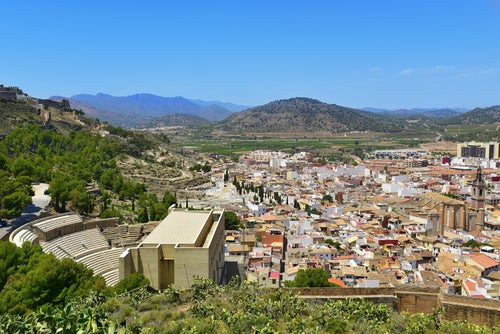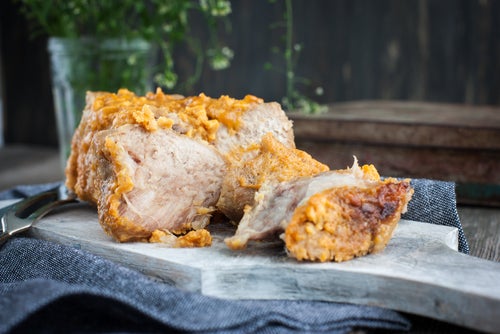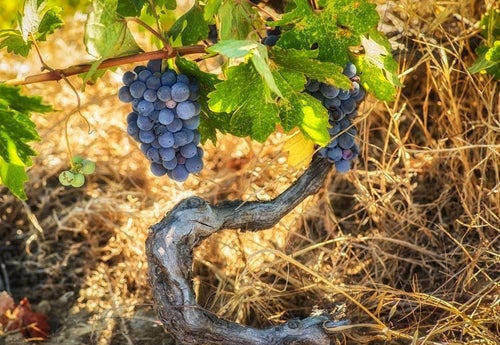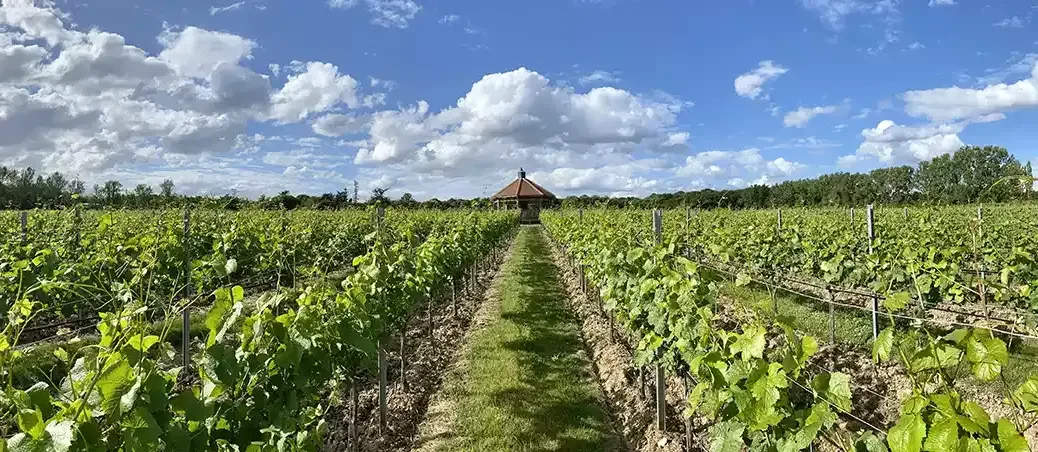
Margaret Rand visits England’s most densely planted corner to discuss with John Atkinson MW the benefits of the area’s clay-rich soils and Burgundy-like climate, as well as the enormous strides made by the Danbury Ridge winery.
It was obvious 20 years ago that you could get good grapes here, but nobody wanted to see.” So says John Atkinson MW, one of the foremost supporters of Essex’s tiny Crouch Valley, and consultant to Danbury Ridge. Now, he says, this is the most densely planted corner of England—with vines, obviously—and the two pieces of land that Danbury bought in 2023–24 to bring the total, once all is planted, to 88 acres (35.5ha), cost it a lot more per acre than the £8,000–9,000 it would be worth as ordinary agricultural land. Jackson Estates, it is said, have been paying a lot more again in these parts.
Is it a bubble? Or is this warm, dry corner of the east coast of England—where Pinot Noir ripens (so far) every year and has a structure and density that nowhere else (so far) can match—something very special that serious growers need to buy into? At the moment there’s a bit of a gold rush; everyone is trying to nab the best bits of a very small place.
It’s possible to get very detailed geological data, down to around 2.5 sq yd (2 sq m), from the University of East Anglia, says Atkinson. “Burgundy and Bordeaux have privileged areas within bigger areas, and we’re looking for the same here… But there are large family farms round here, tens of thousands of acres, and they don’t want to sell. We had to prise one of our sites from a family of farmers; we paid well. It’s potentially the best site in the country, the Petrus of England… The sites we want would be awful for arable.”
Maybe we should unpick that a bit. Petrus is, famously, on clay, and it grows Merlot. But England is about Pinot and Chardonnay, is it not? And chalk? Up to a point; that point being where the chalk ends, which in the southeast is south of the Thames Estuary, at the Dartford Crossing. North of that, as the ice sheets in the last Ice Age melted, they deposited gravel in waves and ridges and seams. The river then was not as the river is now, or where it is now. And there is clay: smectite clay, sticky London clay, shrink-and-swell clay. It goes down 330ft (100m) or more and, John says, is pretty inert. It’s not in the process of turning into anything else: “It’s a cul-de-sac at the end of weather.” And it’s been there for about 45 million years. For arable, the land round here is lean and mean, says Atkinson. It’s good for training racehorses because it’s well drained; it has the best climate but the worst soils. But for vines…
Heather and Mike Bunker bought a house near the village of Danbury in 1988. Then they bought some land. Then one day, somebody suggested they should plant vines. And they listened.
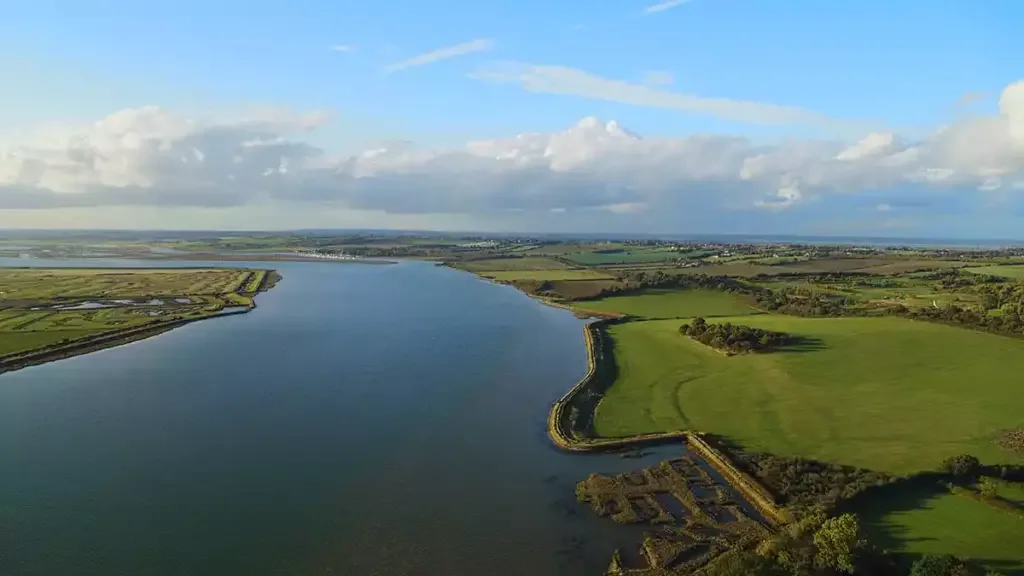
They had both been born and brought up in Southend, a few miles to the south, on the coast. Michael had worked in asset management for GAM, and they’d lived in Hong Kong for some years. When they returned to Essex, it was not with any plan of starting a business; and when they did start one, it was with the intention of leaving a legacy to daughters Sophie and Janine.
It happened, as the best things do, by chance. They’d bought land and contracted it to a farmer, who then complained that it was dreadful—too hot and dry—for arable crops. One day in 2012, a friend came over for a dog walk; their daughter worked at Sixteen Ridges, a vineyard in Worcestershire, and commented that the Bunkers’ land would be good for vines. “The idea was planted,” says Janine Hurley, the Bunkers’ older daughter. “In 2013 they conducted a full feasibility study into the land and the climate, and it ticked all the boxes.” The first 12 acres (5ha), the Octagon Block vineyard, was planted in 2014.
The Bunkers took advice from Duncan McNeill, who knew the area well, and they asked the Thienponts at Vieux Château Certan about rootstocks. “They were very generous,” says Mike, and made them focus on drought. “Here it will get warmer and drier. We have to pick land that will sustain vines over 30 or 40 years.” In 2016, they took the first crop, which they sold to Lyme Bay in Devon. Liam Idzikowski, then winemaker at Lyme Bay, made a wine out of those grapes alone, and in 2017 the Bunkers thought that if they could produce grapes that good, they should be able to put in the rest of the things you need. “You need a clear objective,” they say.
A moment later, it seems, Idzikowski (who used to be an amateur jockey in Northern Ireland until he discovered wine and found out, to his pleasure, that it was made in climates warmer and drier than that of the Six Counties) was winemaker at Danbury Ridge, and designing a winery. It was not done on the cheap. The buildings look beautiful as well as functional, and the winery was set up for both still and sparkling wine. The most Janine will say about the cost is that they have “invested more than we expected.”
They planted for both still and sparkling because they thought initially that Pinot would work only two years out of five, and sparkling would be their fallback. But so far it has ripened every year.
Not only in France is clay key
So, is Danbury Ridge about climate or soil? Both, says Atkinson. But it’s certainly not about chalk. “Smectite clay, which is Pomerol clay, and it’s also at Latour, Cheval Blanc, and Yquem, needs to be over 60% of the soil; the balance of clay minerals needs to be toward smectite, away from kaolinite and illite. We have good clay going east… The minerals in clay are crucial in how it performs.” When you pick up a lump of smectite clay, it’s hard, like concrete, and heavier than it looks. It’s not soil that you would want to have to dig.
There’s deep gravel, too. The Polo Field vineyard is gravel, and the Octagon Block vineyard (where the octagonal wooden building that gives the site its name is, inevitably, on the best bit) is 60% compacted gravel; next to it is deep, solid gravel. “Glacial soil means having 10m [33ft] of gravel right next to 3m [10ft] of gravel, which makes a huge difference.” He adds, “This is the most mixed soil in the region. Other sites are nearly all clay.” Pinot in warm, dry years is very good on gravel over clay, he says. When it rains, the danger is that the grapes take up water, and you get swelling and botrytis. “On clay, the rain doesn’t get in. It just sits on top, and you get no dilution… There’s an interstitial gap in smectite clay. It has a negative charge, which can pull water off the clay. Other clays don’t have that gap, so they don’t shrink and swell, and they don’t have water-holding capacity.”
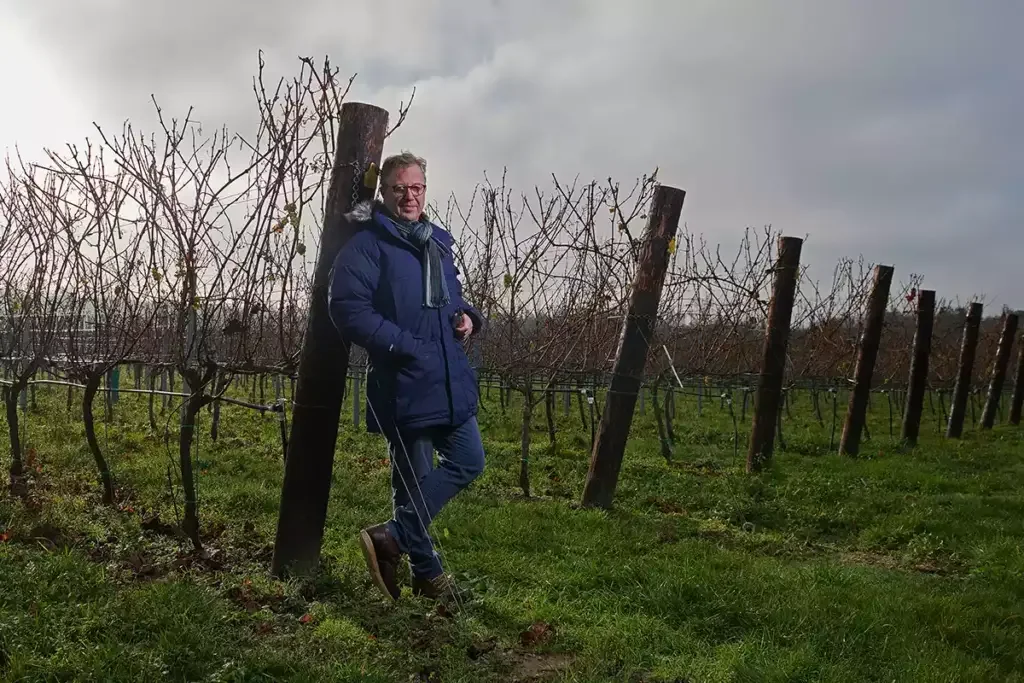
It’s the availability of water from clay in wet years and dry years that is crucial. The surface seals so water can’t get in, so you have consistent water content from one year to the next—like Petrus, he adds, again. The clay has a buffering effect. “The best soils have that consistency below ground. In Burgundy there are shallow soils, with aquifers between.”
Ah, Burgundy. That’s Burgundy where they grow Pinot Noir and Chardonnay, yes? Yes—and Atkinson points out that the narrative in Burgundy has moved away from limestone, and toward clay, over the past 20 years. In Bordeaux, too, they’re more interested than they were in clay, and perhaps less in gravel. The great influences in turning growers on to clay have been Professor Kees van Leeuwen at Bordeaux Sciences Agro and soil consultants Claude and Lydia Bourguignon. Even Atkinson started out thinking that gravel would be better at Danbury Ridge, “but clay surprised us when there was a wet end to harvest, as in 2020. Ripeness was not impeded by the weather being very wet, so we started to look at what was happening in clay soils. Clay’s capacity for holding water is very high, but the rate of extraction by the vine is often very slight. So, I did a deep dive into London clay.”
It was less messy than it sounds. London clay, for those unfamiliar with it, sticks to your boots until you seem to be lifting twice your body weight with each step. Gardeners hate it; people with houses prone to subsidence hate it. Fossil hunters like it because it preserves well, but unlike chalk (another great source of fossils), it is neither pretty nor clean. It is not attractive stuff.
The result of that deep dive was a 2021 report on which Atkinson collaborated with Lee Jones of the British Geological Survey: Clay Soils & Wine. London clay was deposited in what was the London Clay Sea, which was a mixture of “silty lagoons, sandy beaches, and clay depths,” says the report; and the dominant mineral in the clay is illite. Atkinson, however, wants more smectite than illite, because smectite gives more of the plasticity, the shrink-swell, that he is after. And while London clay occupies about 2,470 sq miles (6,400 sq km) as subcrop and 890 sq miles (2,300 sq km) as outcrop, smectite-rich clay accounts for a much smaller area. There’s a strip of it going north from Shoeburyness, on the north side of the Thames Estuary, through Great Wakering and Canewdon. (Wikipedia, tiresomely, debunks the idea that Canewdon is named after King Canute, although he had a camp around these parts and the village sign depicts him knee-deep in water, having demonstrated that he was unable to hold back the tide.) And Canewdon is where Danbury Ridge has bought and will plant 15 acres (6ha).
It’s on the south side of the River Crouch. This seems counterintuitive, because on the north side you get south-facing slopes; however, south of the river, where you have to search for the right aspect, you get more sunshine hours: 1,850 against 1,140, which is already quite a lot. Suddenly you’re in the same bracket as Colmar or Dijon. With only 18in (450mm) of rain per year, it’s even semi-arid. There’s 30% more rain in Libourne than there is in Shoeburyness, but the evapotranspiration rate in Essex is 30% less, so it amounts to very much the same thing. Because it’s so close to the sea here, there’s a lot of light. The wind direction is cross-shore or off-shore, rather than onshore. Botrytis isn’t an issue, and nor is frost, either spring frosts or early November frosts.
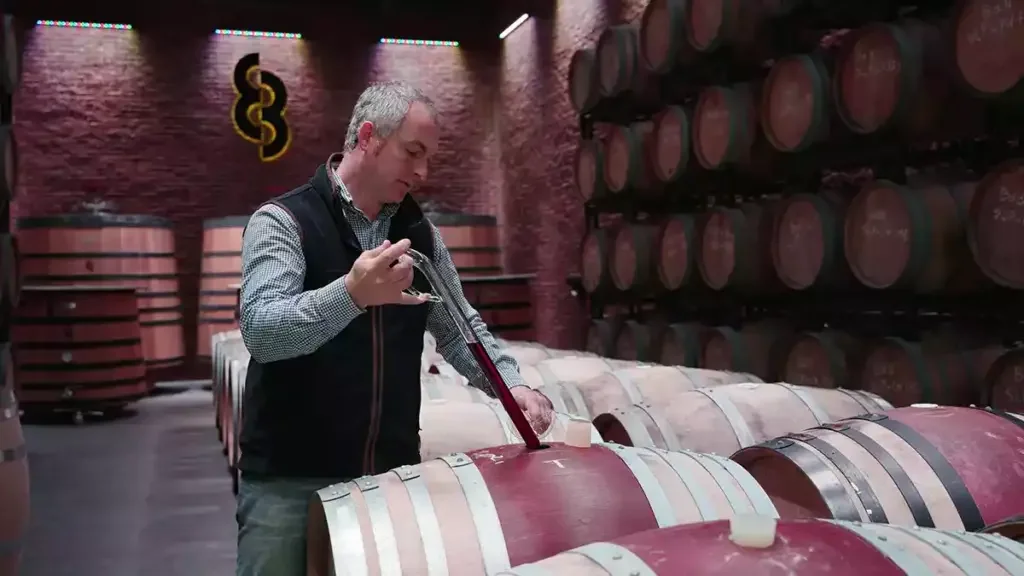
Danbury Ridge: From Crouch Valley to the world
All these comparisons are with still-wine areas for a very good reason: Danbury Ridge is mostly about still wines. Yes, they make about one third sparkling as well, and more of that later, but, in a throwaway statement guaranteed to raise hackles, Atkinson says that “the global game is still wine. You have to be involved in it. Sparkling is like beach volleyball. Still wine is like football.” Not in terms of seriousness or skill, he means (at least, I think he means), but in terms of global importance.
The climate here, as we’ve said, is warm and dry, and in 2018 the grapes ripened well, to still-wine ripeness; they did it again in 2019. In 2020, they made still and sparkling, and the same in 2022 and 2023. “There will be years when we won’t make still Pinot or Chardonnay,” says Atkinson, but so far so good.
The vines are micromanaged. They’ve dug a reservoir (and stocked it with trout), so they can use drip irrigation, but they stop irrigating at fruit-set. “If we restrict to between 55 and 60% of the vines’ water needs, it kicks off different genes and the vines’ energy goes into ripening. Clay is easier than gravel for this. Gravel gets very warm; it’s always advanced.” He adds, “Stress can be a curse in many places, but not in England. Here it means smaller berries and more concentration.”
Grapes for still wine and grapes for sparkling are obviously not interchangeable. But even if those intended for still wine don’t hit the right ripeness level, they might still not be right for sparkling—they can have too much flavor. They can be used as reserve wines for sparkling—a bit more ripeness is possible there—but basically, some blocks make still, some blocks make sparkling. Atkinson favors German clones of Pinot, even though he trained in Burgundy; he likes F105s and FR1801. The clusters are looser, he says, whereas French clones (777, 828, and 943) are more compact. And “the German clones are buffered on gravel, particularly after veraison, when water uptake can cause berries to swell, so there’s room for expansion. FR1801 is bulletproof. French clones work on clay soils where the percolation rate is very low and dipole water molecules H++/OH- bind to clay (clay charge is negative)—hence the cluster expansion is reduced relative to gravel, which has rapid percolation and no charge. They all have their pluses and minuses, depending on the season, though German clones tend to be more expressive when young.”
The winemaking is simplicity itself. Chardonnay is pressed and goes into barrel for between 12 and 18 months; they do little to it, maybe bâtonnage once before it goes into tank. It’s usually bottled unfiltered. Pinot Noir is destemmed, put into concrete vats with a couple of punch-downs per day, and aged for between 12 and 18 months. For sparkling, the must is oxidized early, then treated reductively; it goes into barriques for four months, and some goes into foudres. The barrels come from Chassin; and from François Frères for Pinot, and Rousseau for Chardonnay. All come and taste and tailor their barrels accordingly.
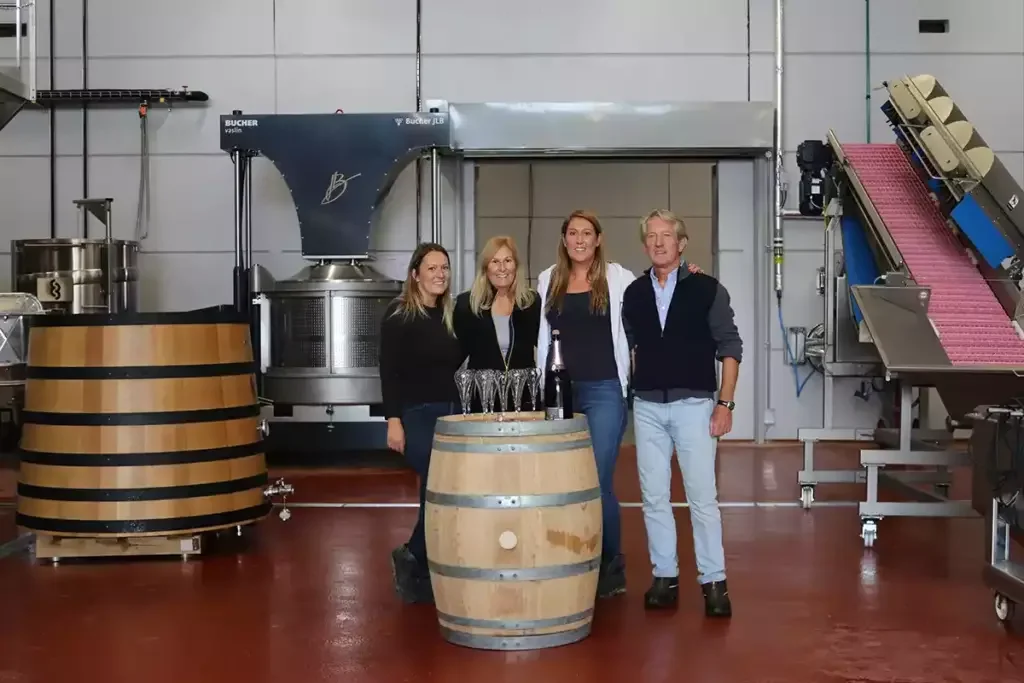
Atkinson is, technically, a consultant, but he is thoroughly involved with Danbury Ridge; he’s not just a visitor. Suddenly, in the middle of lunch, a discussion erupts about bubbles: “John wants more,” says Idzikowski. Atkinson explains, “We have three or four discussions going on at any one time. Something will occur to me at 2am, and the messages start at 5am.” “When the medication wears off,” grins Idzikowski.
Hurley says of the two of them, “John brings a huge amount of knowledge, and as a person he has a more creative flamboyance. Liam is more methodical; he’s less of a risk-taker than John. He bases his decisions on previous experience. Oh, and they’re both awful to work with.” That last comment is a joke, obviously.
Is the Crouch Valley on the edge of becoming an internationally known name? Atkinson thinks it’s not far off. “People were talking about Essex ten or 12 years ago, but it was always what could be. It took the Bunkers to do it.”

